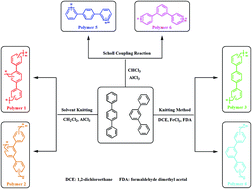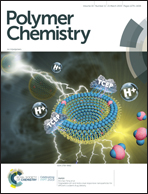Effects of synthesis methodology on microporous organic hyper-cross-linked polymers with respect to structural porosity, gas uptake performance and fluorescence properties†
Abstract
The structural characteristics of hyper-cross-linked polymers (HCPs) make them interesting for a wide variety of applications. To form knitted HCPs various synthesis approaches including solvent knitting, a knitting method using formaldehyde dimethyl acetal (FDA) as an external cross-linker and the Scholl coupling reaction have been used. However, a systematic study of these strategies has not been explored. Here HCPs have been made using facile synthesis methodologies and characterized to reveal resulting Brunauer–Emmett–Teller (BET) surface areas up to 2278 m2 g−1 and 2064 m2 g−1 with CO2 adsorption capacities of 20.89 wt% and 18.95 wt% (at 273.15 K/1.00 bar), respectively. Detailed information is also given with respect to distinctions in textural properties, gas uptake performances and optical properties. More importantly, our comparative studies have revealed the significance and efficiency of solvent knitting when used to fabricate HCP materials with good porosities and gas uptake abilities. Among these approaches, the knitting method with FDA as an external cross-linker is the most time-efficient technique, whereas the Scholl coupling reaction has advantages for the production of fluorescent polymers. Based on the proposed mechanisms, changes in structural features can also be rationally explained.

- This article is part of the themed collection: Polymer Chemistry 15th anniversary regional spotlight collection: China


 Please wait while we load your content...
Please wait while we load your content...